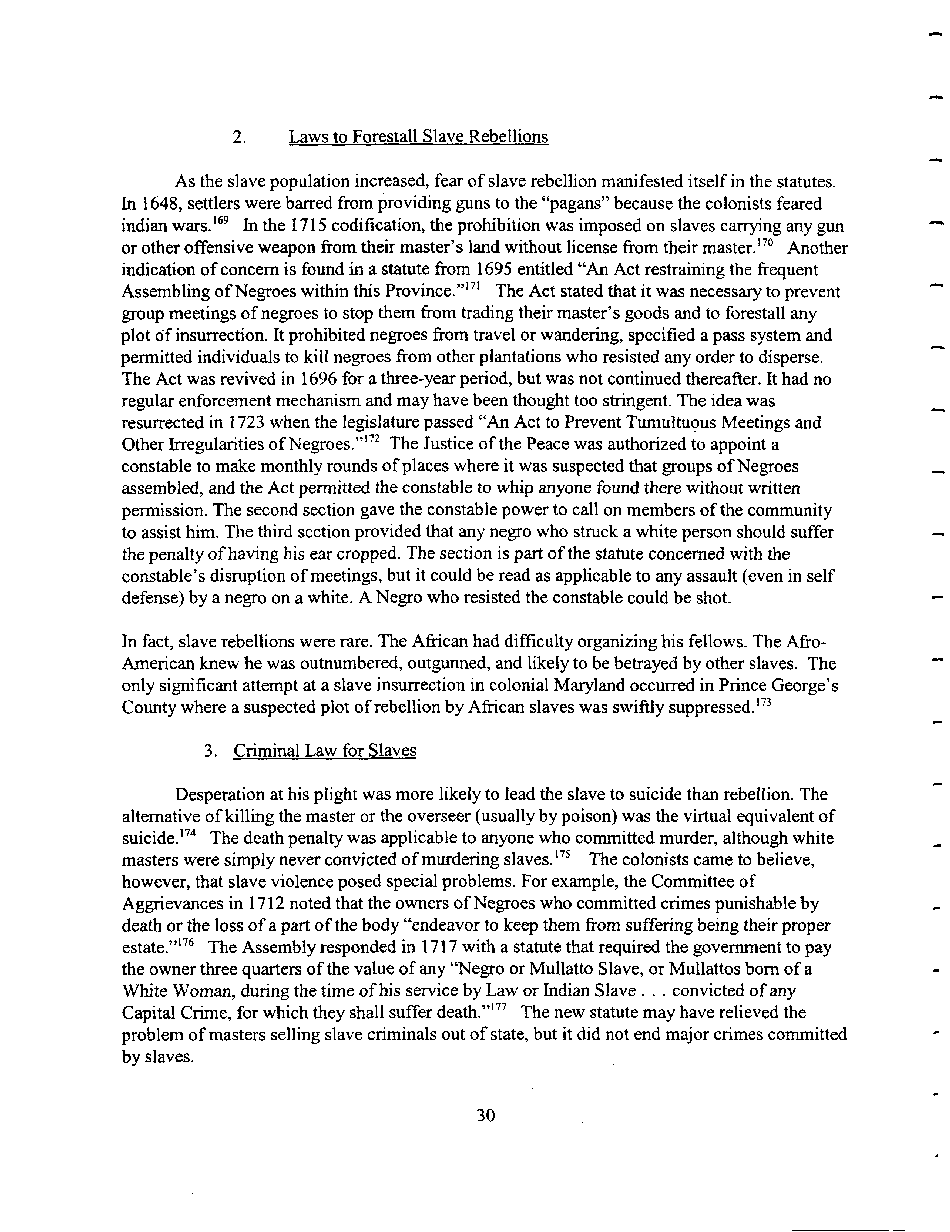|
2. Laws to Forestall Slave Rebellions
As the slave population increased, fear of slave rebellion manifested itself in the statutes.
In 1648, settlers were barred from providing guns to the "pagans" because the colonists feared
indian wars.169 In the 1715 codification, the prohibition was imposed on slaves carrying any gun
or other offensive weapon from their master's land without license from their master.170 Another
indication of concern is found in a statute from 1695 entitled "An Act restraining the frequent
Assembling of Negroes within this Province."171 The Act stated that it was necessary to prevent
group meetings of negroes to stop them from trading their master's goods and to forestall any
plot of insurrection. It prohibited negroes from travel or wandering, specified a pass system and
permitted individuals to kill negroes from other plantations who resisted any order to disperse.
The Act was revived in 1696 for a three-year period, but was not continued thereafter. It had no
regular enforcement mechanism and may have been thought too stringent. The idea was
resurrected in 1723 when the legislature passed "An Act to Prevent Tumultupus Meetings and
Other Irregularities of Negroes."172 The Justice of the Peace was authorized to appoint a
constable to make monthly rounds of places where it was suspected that groups of Negroes
assembled, and the Act permitted the constable to whip anyone found there without written
permission. The second section gave the constable power to call on members of the community
to assist him. The third section provided that any negro who struck a white person should suffer
the penalty of having his ear cropped. The section is part of the statute concerned with the
constable's disruption of meetings, but it could be read as applicable to any assault (even in self
defense) by a negro on a white. A Negro who resisted the constable could be shot.
In fact, slave rebellions were rare. The African had difficulty organizing his fellows. The Afro-
American knew he was outnumbered, outgunned, and likely to be betrayed by other slaves. The
only significant attempt at a slave insurrection in colonial Maryland occurred in Prince George's
County where a suspected plot of rebellion by African slaves was swiftly suppressed.173
3. Criminal Law for Slaves
Desperation at his plight was more likely to lead the slave to suicide than rebellion. The
alternative of killing the master or the overseer (usually by poison) was the virtual equivalent of
suicide.174 The death penalty was applicable to anyone who committed murder, although white
masters were simply never convicted of murdering slaves.175 The colonists came to believe,
however, that slave violence posed special problems. For example, the Committee of
Aggrievances in 1712 noted that the owners of Negroes who committed crimes punishable by
death or the loss of a part of the body "endeavor to keep them from suffering being their proper
estate."176 The Assembly responded in 1717 with a statute that required the government to pay
the owner three quarters of the value of any "Negro or Mullatto Slave, or Mullattos born of a
White Woman, during the time of his service by Law or Indian Slave . . . convicted of any
Capital Crime, for which they shall suffer death."177 The new statute may have relieved the
problem of masters selling slave criminals out of state, but it did not end major crimes committed
by slaves.
30
�
|

